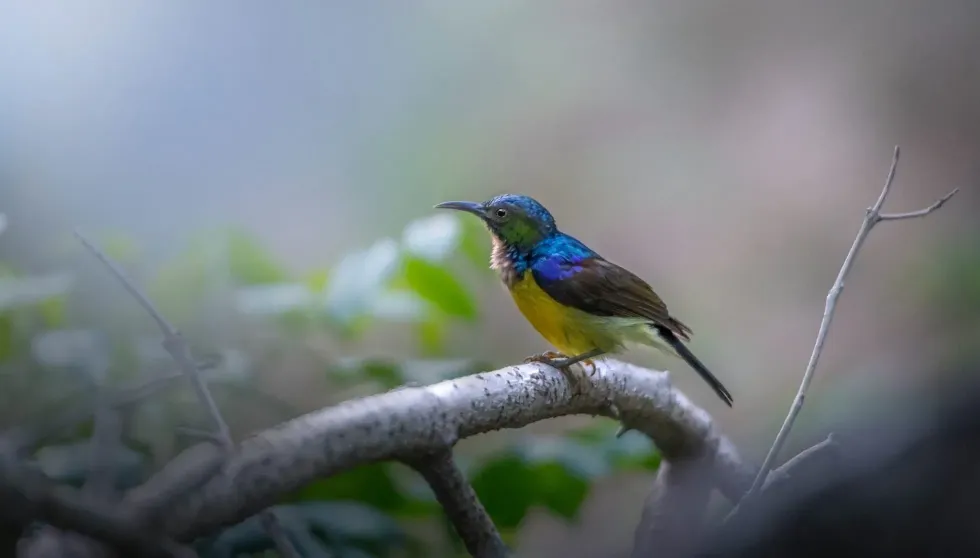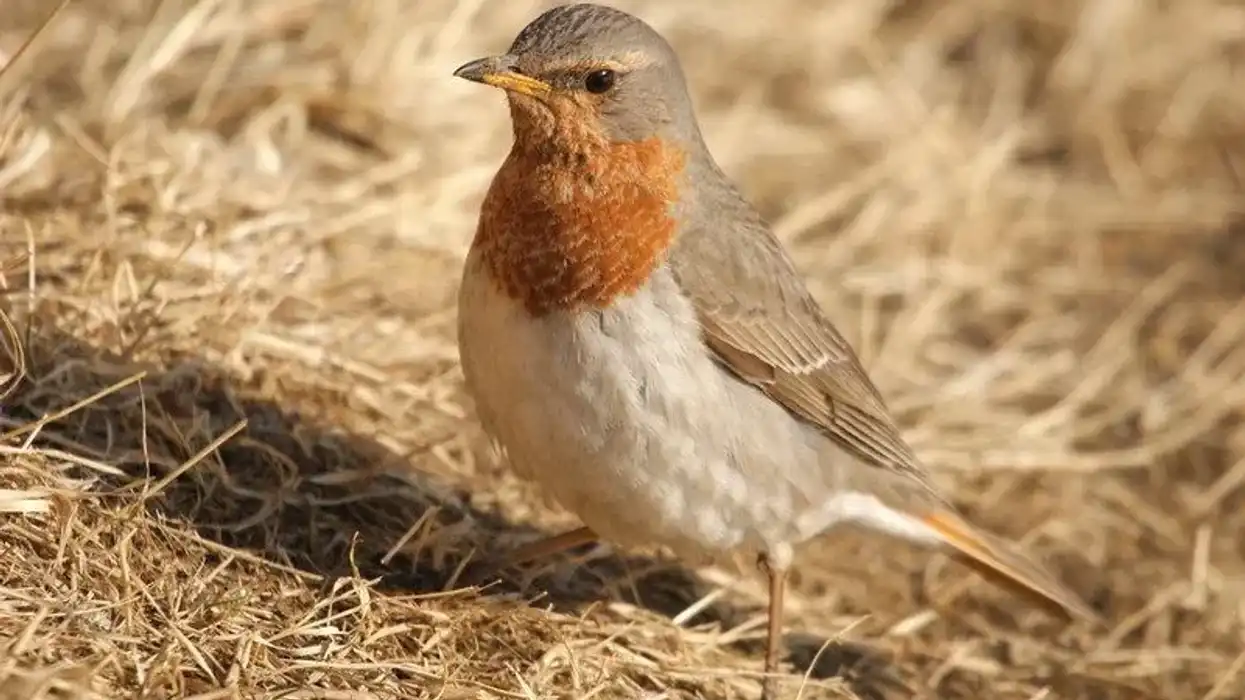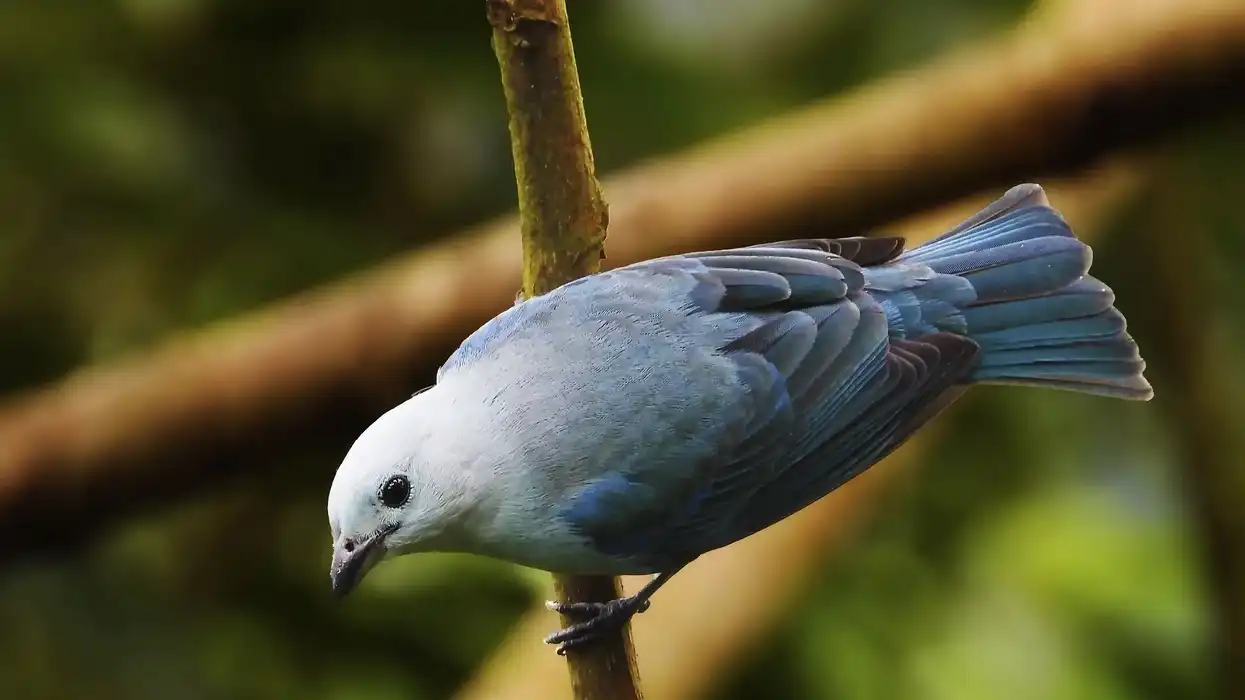The blue-throated hummingbird (Lampornis clemenciae), also known as the blue-throated mountain-gem is one of the biggest hummingbird species in North America and the USA, mainly in Western Texas and Southeastern Arizona. It is known for feeding on flower nectar and it lives in canyons, pine-oak forests, mountains (in Southeastern Arizona), and the North American woodlands.
Their diets also include many insects. It is an aggressive species of bird that dominates other birds if it feels like its territory is being threatened.
It imposes authority over sugar water feeders too.
Although it is named the blue-throated hummingbird, only the males of the species have the blue throat patches, which may even look grayish sometimes. Harder to miss are the white stripes on its face and head.
They live for close to 10 years and perform singing rituals before breeding. The populations show an overall increasing trend, and the blue-throated mountain-gem is considered by the International Union for Conservation of Nature (IUCN) to be a species of Least Concern.
Keep reading below to know more. For more relatable content, check out these hummingbird interesting facts and bee-eater facts for kids pages.
Blue-Throated Hummingbird Interesting Facts
What type of animal is a blue-throated hummingbird?
The blue-throated hummingbird (Lampornis clemenciae) or the blue-throated mountain-gem is a bird.
What class of animal does a blue-throated hummingbird belong to?
The blue-throated hummingbird (Lampornis clemenciae) or the blue-throated mountain-gem belongs to the Aves class of animals.
How many blue-throated hummingbirds are there in the world?
The exact number of blue-throated hummingbird (Lampornis clemenciae) or blue-throated mountain-gem birds in the world is unknown.
Where does a blue-throated hummingbird live?
The blue-throated hummingbird (Lampornis clemenciae) species lives in the mountainous woods, in the North American countries of the USA and Mexico. In the USA, the blue-throated hummingbird range map consists of the Madrean pine-oak woodlands in the territories of Western Texas, Southeastern Arizona, and southern parts of New Mexico.
In Mexico, it mainly inhabits northeastern Sonora, and its time in Southeastern Arizona is during the winter. The species is rarely found outside of North America.
What is a blue-throated hummingbird's habitat?
The blue-throated hummingbirds live in mixed and coniferous woods, usually up in the mountains of North America. They inhabit the areas close to river streams and flowers, in elevations between 4,500-11,500 ft (1,371-3,505 m) in Southeastern Arizona, Southern New Mexico, and West Texas.
They choose even higher habitats in Mexico, close to 12,800 ft (3,900 m), in pine-oak and pine-fir forests, and canyons.
Sometimes, they may be seen in moist places in deserts, and deciduous forests. Blue-throated hummingbirds also visit sugar feeders in the human settlements close to their preferred habitats, particularly the feeding stations that have been installed in Southeastern Arizona.
Who do Blue-throated Hummingbirds live with?
The blue-throated mountain gem (Lampornis clemenciae) lives alone most of the time, except for the breeding season.
How long does a blue-throated hummingbird live?
The blue-throated hummingbird lifespan is 10-12 years.
How do they reproduce?
Blue-throated hummingbirds reproduce by mating and laying one or two white eggs. The males sing and call when they want to breed, and the female blue-throated hummingbirds may reciprocate with their own calls.
The female blue-throated hummingbirds however are solely responsible for building and defending the nest, incubating, and tending to the young for about 25 days, after which they leave the nest. Blue-throated hummingbirds may have three broods per year if there are ideal conditions, usually during the months of April-September.
What is their conservation status?
The conservation status of the blue-throated hummingbird species, according to the International Union for Conservation of Nature is Least Concern. Although immediate conservation is not needed for the blue-throated hummingbird, conservation organizations have been set up for a very similar species, the blue-throated hillstar.
Blue-Throated Hummingbird Fun Facts
What do blue-throated hummingbirds look like?
The blue-throated hummingbird is one of the biggest species of hummingbirds. It is 4.3-4.9 in (11-12.5 cm) long, has a wingspan of 2.3-3.1 in (5.9-7.9 cm), and weighs 0.2-0.6 oz (6-10 g).
It has a long thin bill and a big, big tail. Its steering tail feathers have white edges.
The distinguishing feature, the blue throat patch, is only present in males, and sometimes it isn't easily noticeable on them either. The upper half of the blue-throated hummingbird's body is green, with a rump that is bronze. the tail appears a darker green, with the upper tail feathers being black with shades of blue.
The belly and the underside are gray, and the wings are dark gray with some green. The immature blue-throated hummingbird males also lack blue throats.
Juvenile females closely resemble adult female blue-throated hummingbirds. Also, a prominent feature is the two white stripes on the face, both above and below its eyes.

How cute are they?
The blue-throated hummingbird is a truly magnificent hummingbird. These North American hummingbirds are gorgeous creatures with the white facial stripes, the blue throat, and the blue-black tail being the stand-out features.
Another endearing thing about them is that they like eating 'sweet food'. Their preferred food is the sweet nectar of the flowers. These birds do have an affinity for sugar water that is put out for them in feeders, although they do tend to fight each other for it.
How do they communicate?
The blue-throated hummingbird communicates via songs and calls. The male sings more than the blue-throated hummingbird female. It may be a simple, squeaky 'peep' song, or a complex eight-second-long 'whisper' song.
The female may reciprocate with her own song during the breeding season. The songs of this bird can be described as sharp and atonal, and its vocal range is between 1.8-30 kHz. Blue-throated hummingbirds also use ultrasonic waves to flush out prey.
How big is a blue-throated hummingbird?
Blue-throated hummingbirds are 4.3-4.9 in (11-12.5 cm) long and have a wingspan of 2.3-3.1 in (5.9-7.9 cm), which makes them two times bigger than a bee hummingbird. It is only slightly bigger in size than Anna's hummingbird, as well as the Rufous hummingbird.
How fast can a blue-throated hummingbird fly?
Blue-throated hummingbirds can fly at speeds of 20-30 mph (32-48 kph)
How much does a blue-throated hummingbird weigh?
A blue-throated hummingbird may weigh 0.2-0.6 oz (6-10 g).
What are the male and female names of the species?
The male and the female blue-throated hummingbirds are not called by specific names.
What would you call a baby blue-throated hummingbird?
A baby blue-throated hummingbird may be called a chick.
What do they eat?
Blue-throated hummingbirds mostly eat flower nectar. They are also known to feed on insects, spiders, wasps, and other invertebrates.
Are they poisonous?
No, blue-throated hummingbirds are not poisonous.
Would they make a good pet?
No, blue-throated hummingbirds would not make a good pet.
Despite its diminutive size, the blue-throated hummingbird is a magnificent hummingbird as it is one of the most aggressive defenders of its nest, even attacking hawks! They sometimes happen to live close to small human settlements and may visit sugar feeders if humans put them out, but they won't spare humans if they felt their nests were threatened.
Also in places like Canada and the USA, it would be illegal to possess a blue-throated hummingbird since it is a migratory wild bird.
Did you know...
The blue-throated hummingbird daylily flower is named after the bird that likes to feed on its nectar.
The blue-throated hummingbird phylum is Chordata, which signifies animals supported by a principle skeletal chord.
Being a popular bird, blue-throated hummingbird pictures are easy to come by on the internet. A characteristic male blue-throated hummingbird picture should contain the blue throat patch that gives it its name.
A Utah blue-throated hummingbird is a bit of a rare sight since the Utah territory is known for black-chinned and broad-tailed hummingbirds.
When it comes to stand-out features, the blue patch on the throat of the blue-throated hummingbird and purple head of the Costa's hummingbird, are well-known.
The nest is utilized by the female as a base for future nests. A nest tower is built eventually, with each new nest going over a previous nest.
There are some differences between the male and female ruby-throated hummingbirds. Only males have the eponymous ruby throat while the females have a gray, dull throat. Females are slightly bigger than males. Males have forked tails with black feathers pointing outwards, females have rounded tails that are rounded, white-tipped, and mostly black.
Hummingbirds will not die if you touch them. They are known to die by flying into windows and buildings, but not just by being touched. It is illegal to possess them in the USA though.
Hummingbirds do stop flying for nesting and sleeping. They fly most of their time but they do stop.
What is the difference between a male and female blue-throated hummingbird?
The defining feature of the blue-throated hummingbird is the iridescent blue throat patch (gorget), but only the males have this. The female of this large hummingbird species instead has a gray throat instead of a blue throat.
The males of these North American birds are the more prolific singers. The females may sing in response to the males during the breeding rituals, or when she wants to defend her nest.
The males share no nesting or breeding duties outside the actual mating. The females build elaborate nests from plant fibers, fern, spider webs, that hide in plain sight. The female also does the incubating, defending of nests, and raising of juveniles.
Why is the blue-throated hummingbird also known as the blue-throated mountain-gem?
The name of the blue-throated hummingbird was changed to the blue-throated hummingbird because it belongs to the genus Lampornis, a group of hummingbirds that inhabit the mountainous habitats in their respective ranges. It contains eight different birds with different colored throats that are 'gems of the mountain'.
Also, there are a total of 112 genera and 361 species of hummingbirds, so separating eight out of those into a single genus 'mountain-gem' was logically sound.
Here at Kidadl, we have carefully created lots of interesting family-friendly animal facts for everyone to discover! Learn more about some other birds from our palm warbler surprising facts and blue jay facts pages.
You can occupy yourself at home by coloring in our free printable blue-throated hummingbird coloring pages.









